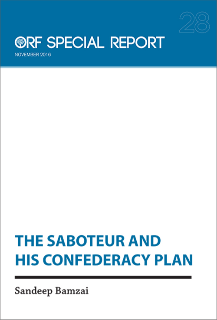"Media reports that the Election Commission (EC) was considering implanting a ’verification mechanism’ in the electronic-voting machines (EVM) to be deployed in the four-State Assembly polls could have anything but the intended consequences. In effect, such a move may lead to relatively easy and at times motivated identification of locality-wise voter-behaviour, though that of individual voters too may not be impossible, if a losing candidate and/or his party tried hard enough - that too deploying the existing legal and judicial processes.
In a way, the introduction of EVM, first on an experimental-basis in the Parur Assembly by-election in Kerala State, heralded electoral reforms, initiated by the EC. Subsequent nation-wide extension of the same, almost at one-go after a larger trial run in the Haryana Assembly polls, also showed up Indian democracy for what it has been really worth. It came about long after the ’illiterate Indian masses’ had shown their inherent adherence and respect for the institution in the post-emergency polls of 1977. The EVM also exposed the pre-conceived notions of the rest of the world - and also pessimists within the country - that technology was after all not a rich man’s preserve, and a Third World nation could neither not afford it, nor implement it.
Against the ’hanging chard’
That it happened in the world’s largest democracy, perceived at times by the West as unmanageable, when the world’s more famous democracy in the US was caught in the ’hanging chard’ electoral scam did not go unnoticed. Many Americans in different States were also still pencilling in their electoral choice under an overall scheme that left much to be desired.
It was also then that much of the rest of the world got to know that the US still did not have a constitutionally-mandated, independent electoral authority capable of being uninfluenced by the elected Government/Governor in the States, and that there was no federal poll panel, as should have been the case. India then showed that the US too could take a few electoral lessons from it. The situation has only improved in India’s favour, since.
The EVM exposed the Indian masses to technology at the touch of a button. There has not been any going back, not only for electronic voting in the country, or for technological advancement of rural India. It also convinced India and Indians that a determined few could still enforce beneficial measures at the grassroots-level, if backed by popular imagination and acceptance.
Mixing the ballot-paper
The success of the EVM experiment in a way, and its ready acceptance by the political class on the one hand, and the attestation by the higher judiciary, may have also contributed in no small way to the EC feeling emboldened to try further reforms. Successive CECs from the days of the indomitable T N Seshan and their colleagues have stopped at nothing to clean up the Indian elections, one step at a time - but taking a giant leap, from time to time.
Before the EVM became the norm, not long after it was first introduced, voters used to cast their ballot on a sheet of paper, and deposit in a ballot-box. The large number of ballot-boxes that were used in the Lok Sabha polls, for instance, would outnumber the number of EVM now being deployed - both a world record in itself. Yet, the ballot came with the possibility of exposing individual communities when counted, box by box and/or booth by booth, as used to be the case.
This led to elected candidates invariably not addressing the legitimate concerns of those localities, and at times even led to physical assaults, months and years after the polls. Even the losing candidates were known to have resorted to such assaults. The EC then found an easy way out, by introducing the system of mixing the ballot-papers in empty petrol drums, stirring them with a rod, and then bundling them according to the ballots cast in favour of individual candidates, and then counting them.
This did help stop the ’branding’ of the electors at the counting-centres. This simple solution went a long way in driving out fear from the minds of the electors, in urban, semi-urban and rural constituencies, mass targeting of communities post-poll was not uncommon. Even when courts ordered re-count, based on election petitions, only bundled ballots were counted again. There was no real way of identifying individual voters or localities.
Paper-trail to counter
Recent complaints, often unfounded, particularly by political parties that have lost elections led to demands for a paper-trail, or receipt, for the elector to be convinced that his vote had been cast only in favour of the candidate/party of his choice, and on the symbol that he had pressed the EVM button for. This would have taken out the credibility and confidentiality of the election process at one-go. At another level, political parties and candidates would have made such paper-receipts pre-requisites for paying up electors - or, for beating them up!
The proposed scheme now has a scheme for the installation of a counter in the EVM, on which the elector can verify that the machine would be recording only in favour of the symbol of his choice, as visible on the counter. Of course, there is no paper-trail, and the control of the counter would lie with the chief polling officer of the booth concerned. It looks fine on paper, and only so far. It could create more problems after the first round with the scheme, for the EC and for the faith now the nation has in the electoral process as a whole.
One, the proposal for a ’counter’ of the kind hits at the very base and basis of credibility of the existing electoral scheme, which has been evolved over a century. If credibility-questions are encouraged without proof, it can lead to a situation where other frivolous charges could be raised. Similar doubts and suspicions had been raised even when the EVM was introduced. Some political parties alleged that the ruling party was in control of the public sector companies that manufactured and programmed the EVM, and their technicians would collaborate.
It only needs to be recalled that soon after the 1971 Lok Sabha elections, some responsible Opposition parties joined the media chorus about the use of ’Soviet ink’ that erased the voter’s preference in favour of the ruling Congress party, after a few days. The relatively long gap between the day of polling and counting, for which the ballot boxes in many constituencies across the country had to be carried physically, across mountains and rivers, was also cited as proof to the time-gap required for the chemicals to act. In either case, it was forgotten - possibly wantonly - that any collaboration in such matters would have required hundreds of thousands of election staff, seconded by the EC from State and Central Government services and other public sector undertakings, including banks and insurance companies. As coincidence would have it, their employees and trade unions were mostly anti-Establishment on most occasions. A conspiratorial, collaborative venture of the kind would have been impossible. The same is true of the charges now being revived, that the EVM could be manipulated against the will of individual electors.
Secondly, a counter could cause more confusion and delays in the polling process on the ground. It may be given to any elector - particularly the politically-motivated one - to claim that he did not trust the counter reading, either. Either the elector or the candidate could then go to the court, wanting to re-read the counter-inputs. If no such facility is now being made available, it may still be within the imagination and jurisdiction of the Judiciary to facilitate that as well. In turn, it could lead/contribute to a process for easy, post-poll identification of voters, either as individuals or groups.
Already, the EVM scheme suffers from a possible infirmity in that the elector has to sign in a poll register before casting his vote. An energetic poll agent of any candidate could still note down the serial number of the electoral, and trace back the vote cast, if an imaginative lawyer of his candidate could convince the Judiciary that not stopping with re-counting, the court could and should order a revisit of the polling process as a whole in any particular polling booth.
If this has not happened already, it does not flow that the Judiciary would not take up the cause of the ’faceless voter’ or that of the losing candidate in the future. Should interventions of the kind happen, now or later, that could hit at the very root of democratic politics and elections in the country. In turn, it could strain them to the levels as it used to be until the introduction of the EVM heralded a new and welcome era in the nation’s democracy and election processes.
(The writer is a Senior Fellow at Observer Research Foundation)
"
The views expressed above belong to the author(s). ORF research and analyses now available on Telegram! Click here to access our curated content — blogs, longforms and interviews.




 PREV
PREV


